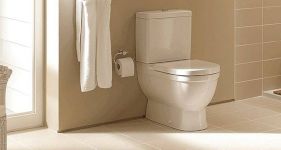How to Install a Kitchen Sink
In this article we explain how you would go about installing your kitchen sink. We detail what the job involves and everything you need to get started.

Table of Contents
- What Tools Do I Need to Install a Kitchen Skin?
- What Safety Equipment Do I Need to Install a Kitchen Sink?
- What Materials Do I Need to Install a Kitchen Sink?
- How to Prepare for Installing a Kitchen Sink
- How to Install a Kitchen Sink Yourself - Step by Step Guide
- Sink Types
- Sink Repair
- How to Remove Sink
- FAQs
What Tools Do I Need to Install a Kitchen Skin?
You want to ensure that your DIY project runs smoothly and successfully, to avoid any hiccups, you will need the correct tools and materials to allow you to install your kitchen sink successfully.
You will need the following tools:
- Flat blade screwdriver
- Pozidriv screwdrivers
- Bucket
- Cloth
If you don't have these tools to hand, then you should be able to purchase these at your local DIY shop.
What Safety Equipment Do I Need to Install a Kitchen Sink?
As you are handling potentially heavy and sharp objects when you install a kitchen sink, it is important that we highlight the importance of safety and protection during this installation process.
- Eye protection glasses
- Gloves
- Get a friend to help you when lifting and moving heavy items
Always read the manufacturer’s instructions and take care when using power tools.
Upon removal of your sink, do avoid lying directly underneath the sink as small parts may fall down during this process. This is why you should wear goggles or protective eye wear during this time.
If at any stage you have any doubts or are uncertain, then please call an expert for advice on any issues you face.
What Materials Do I Need to Install a Kitchen Sink?
You will need to purchase the following materials:
- New sink
- Tap
- Flexible hose connectors
- Isolating valves (if needed)
- Plumbing fittings and sundries
- Sealant (some manufacturers already supply this with your new sink)
- Fixing clips
- PTFE tape
You can purchase the above materials from local DIY stores or locate them online.
How to Prepare for Installing a Kitchen Sink
Taking the time to plan and prepare before learning how to install a kitchen sink in a new counter top will ensure the process goes smoothly and mistakes are minimised.
When considering your new sink unit, it is much easier to fit a bowl with the same depth. If you match your new sink as close as possible to the current sink dimensions to avoid making any significant alterations and changes to the pipework. Similarly, you will also want to ensure you choose a waste that is similar in size. This will make the fitting and reconnect process much easier.
It's important to remember that when you are removing and replacing your old sink and tap that you ensure the water supply to the area is turned off before attempting to remove the appliance. The supply taps have some isolating valves, to turn these off you simply need to turn the screw head at a right angle. If you don't have isolating valves fitted, you may want to consider having these fitted.
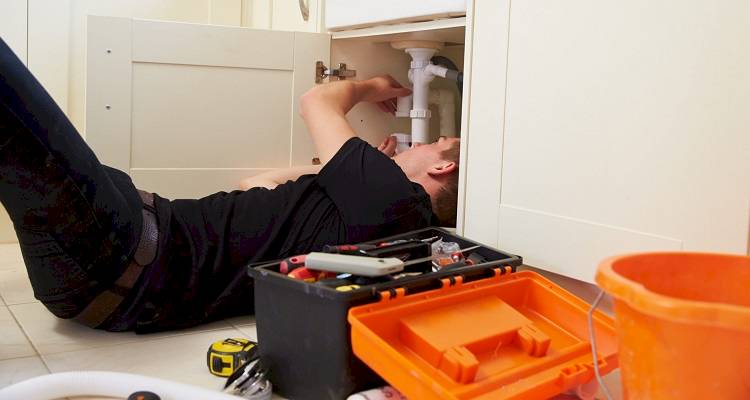
If isolator valves are in place then your water supply will need to be switched off at the mains. Locate your mains stopcock; this could be outside or inside your home. To turn these off, simply turn the stopcock clockwise.
When it comes to replacing the kitchen sink, you should still be able to use your current water supply pipes and outlets. However, you may need to extend the cold and hot water supply pipes if your tap position alters. This is where flexible hoses should be used to allow you to connect the inlet pipes to the water supply.
We also recommend that you assemble the new sink and kitchen sink taps together before removing the old sink. This will give you a chance to make sure all the seals are applied and attached correctly. This will help preparations to run smoothly to ensure the joints are leak-free.
You will find that when you are fixing your new sink in place, that you have some fixing clips provided to you by the manufacturer. These should be used to hold your sink into position, and you will need to attach these to the new sink before fitting. Fix these clips to the worktop and space them out evenly at intervals following the instructions provided.
How to Install a Kitchen Sink Yourself - Step by Step Guide
Step 1
You will need to get help with this step as you will need assistance lifting and carrying your new sink into place. Make sure you are wearing safety gloves for this as the edges can be sharp. Check that the sink fits into the cut out area on your worktop and that the pipes connect correctly.
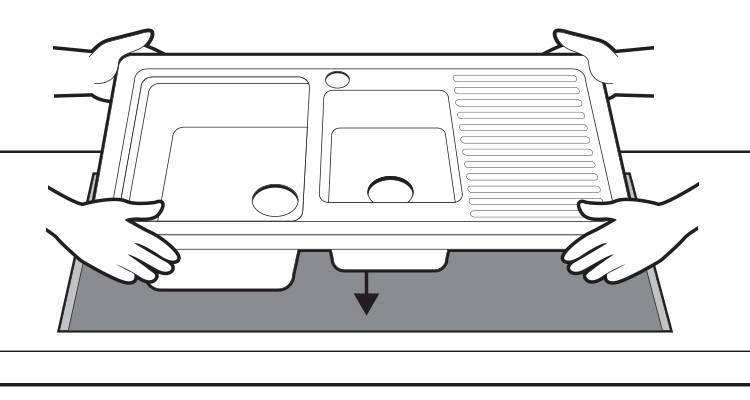
If they do not fit, you may need to refit your pipework and consider purchasing additional pipes to allow it to connect together correctly.
Step 2
Once you are satisfied that the sink unit fits within your worktop, you can then begin to install your sink.
Before fitting your sink, you will need to apply a sealing strip to stop any moisture running between the sink and the worktop. To apply this strip, you will firstly need to begin by resting the sink securely on a worktop with the upside of the sink facing towards the ground. You will need to place the strip on the reverse edge of the sink. You should begin by fixing it down along the outer trim of the sink and running the trim from edge to edge.
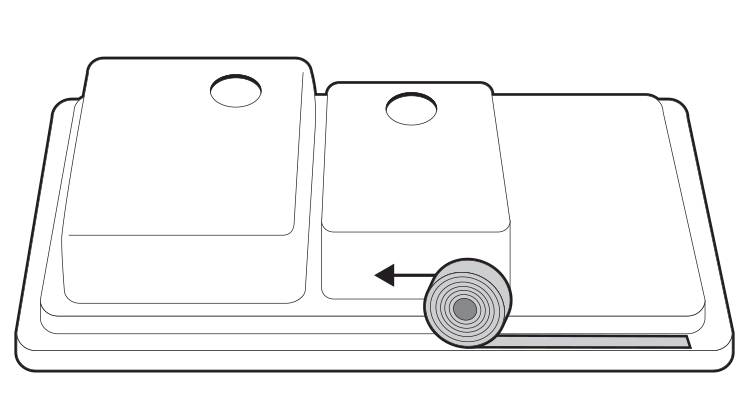
One side of the seal trim will have the adhesive strip, when applying the trim down, remove part of the strip and then run your thumb along the seal in the direction you are lying to secure the trim and ensure this in small sections to avoid any mishaps.
Should your manufacturer not provide you with a sealing strip, then you can opt for silicone sealant or a non-setting compound (plumbers mait). If this is your method of choice, please take care to only use a small amount of sealant as too much will seep out, making it incredibly difficult to clean off any excess.
Step 3
Once you have correctly secured the sink in the surface, you can now begin to work beneath the worktop. Make sure that the space beneath your sink is clear to allow you full access.
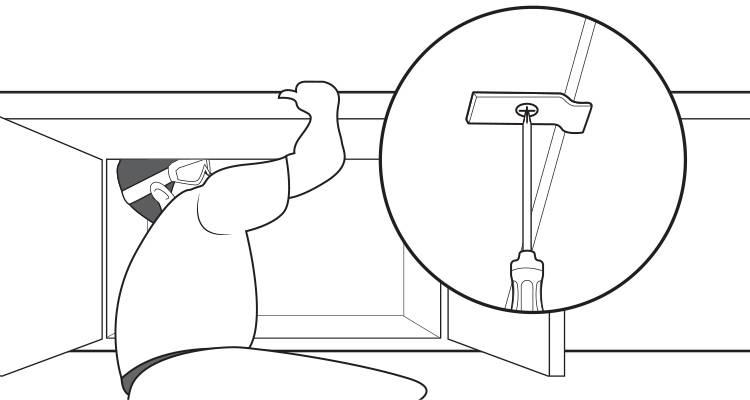
You should start by tightening the sink retaining clips. To do this, you will need to ensure you are wearing your eye protection. Then lay on your black, using a screwdriver to tighten the clips around the edges.
Step 4
At this stage, you can now fit taps into your new sink. Please ensure you follow the manufacturer's guide from the instructions provided.
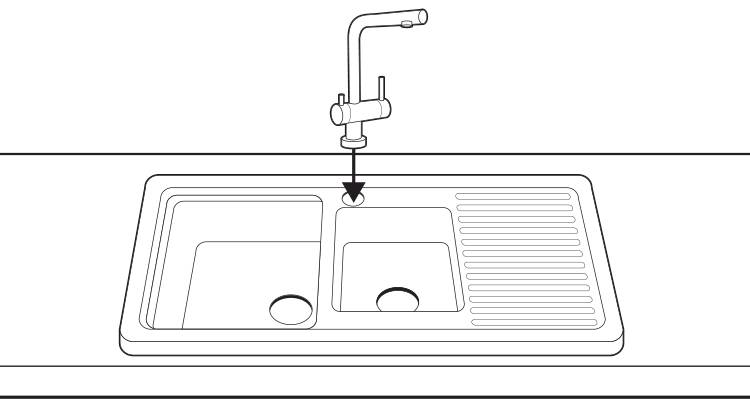
If you are refitting your original taps, you will need to assemble these correctly back into place and connect the tap to the hot and cold water supply via the mains pipework.
Step 5
Using the flexible hoses, you should connect the hot and cold supply and secure the hoses by turning the screw valve. However, you may find some taps have a dual flow design, and this just means hot and cold water can pass directly through the tap in separate tubes, then these will mix at the outlet of the tap.
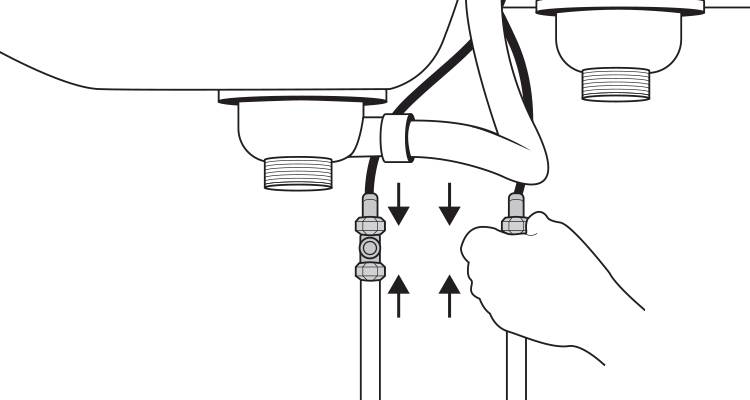
The other design is where the hot and cold water will combine in the body of your tap. If this is your method of supply, then the water regulation or your local bi-laws may require a non-return valve or single check valve to be fitted on both pipes that are connected to the current mixer tap. This is due to the hot and cold water pressure differing.
Step 6
The water supply should now be connected. To check this was successful and be cautious of any leaks in the system, begin by turning the water on via the stopcock. It's important you start with this before the waste pipe is reinstalled.
You should start with a cold tap first, then move onto the hot tap after a thorough check for leaks, only turn the isolation valve/ stopcock a little, to begin with. Check thoroughly for any leaks and ensure that all the connecting joints are tight and secure. After your checks are done, and there are no signs of leakage, you should now open the valve fully and repeat the checks for any leaks.
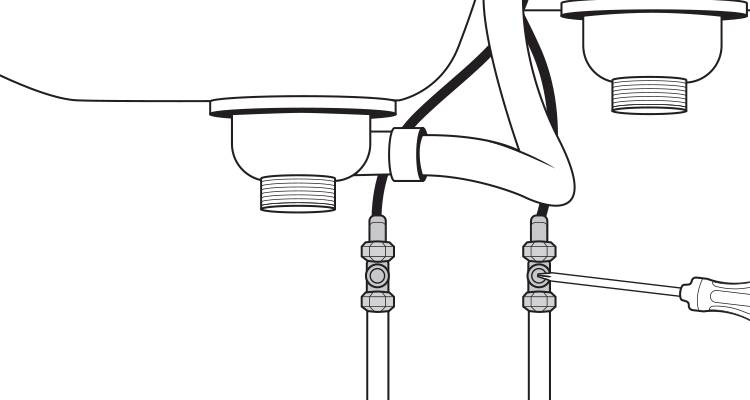
Should you encounter a leak, make a note and mark the area of the leak before turning the water off. Depending on the area of the leak, if it is located at the compression joint then consider wrapping PTFE tape around the olive to stop the leak. Undo the joint first before applying the tape. Don't be tempted to wrap and compress the olive joint too tight.
However, should you find it is the pipework is leaking then this will need replacing and you should at this stage call a plumber.
Step 7
Once the pipework has been checked, and you are happy, you may now move onto fitting the waste pipe. Before you attach the waste pipe to the sink, it is crucial that you check all the jointing and seals on the pipe are in good condition and have been positioned correctly. If you are unsure of the condition of the seals, then we would advise purchasing some new ones, to avoid any accidents down the line.
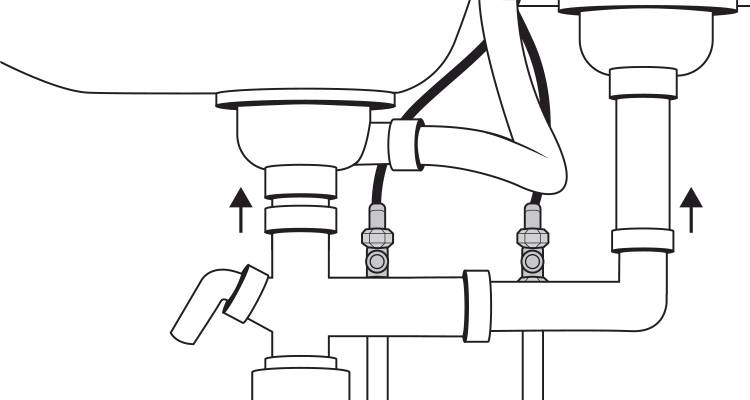
It is at this point it might be useful for you to thoroughly clean any waste and gunk from the u-bend. The waste pipework can now be refitted.
Step 8
You can now turn the water on. Double-check for any leaks.
Should you find a leak in the waste pipework then make a note of the area and turn the water off. Take the seals apart to see if there is any damage. You may just need to tighten the joint up, ensuring you are careful not to over-tighten the plastic seal. If the damage is still not fixed by tightening you will need to invest in some new seals.
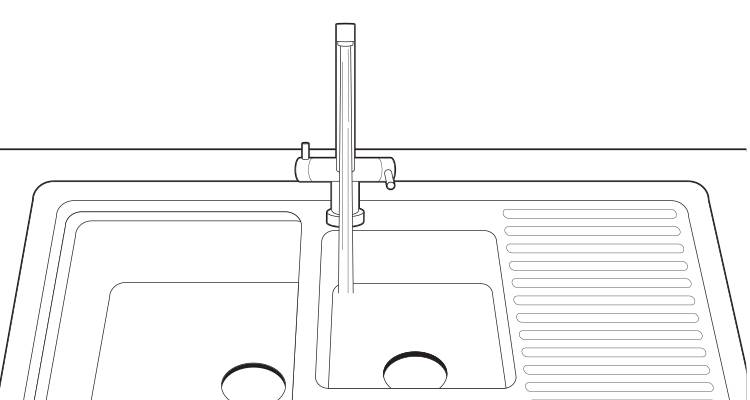
Place the waste plugs into two compartments of the sink, then turn the tap to fill both compartments with water. Once the water level is high, remove the plugs which will release the water. This will apply the maximum waste pressure.
Don't be alarmed if you hear loud gurgling noises from the tap; this is just air bubbles and pressure being released from the supply tap work. If you turn the tap slowly, this will help avoid any splashes.
Sink Types
Before purchasing a new sink for your home, you may want to consider the right type of sink that is most appropriate for you. As much as the types of sinks you can purchase, it is important to also note that sinks can be purchased in a range of materials and finishes to suit everyone.
Drop-In Sink
Also known as a top-mount/self-rimming sink. You will find that this is the most common type of sink in most homes. Following the sink manufacturer's template, a hole is then cut into the work counter and the sink placed in from above then sealed down to the counter.
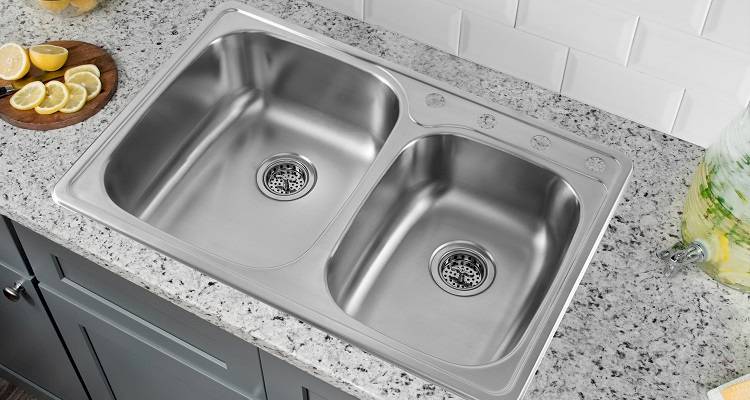
PROS ✔
The great thing about this sink type is that no special skill is required to install this. The cost all in all for the sink and installation is very low, which is ideal if you are on a budget.
CONS ✖
The rim of the sink is raised above the worktop, making it difficult if you want to wipe any dirt or excess water from the countertop surface into the sink. The overall look isn't always to everyone's taste; some homeowners don't like the separation of rim and sink.
Undermount Sink
These sinks are the opposite of drop-in sinks because of the way they are attached. Undermount sinks are attached to the bottom of the counter with special clips.
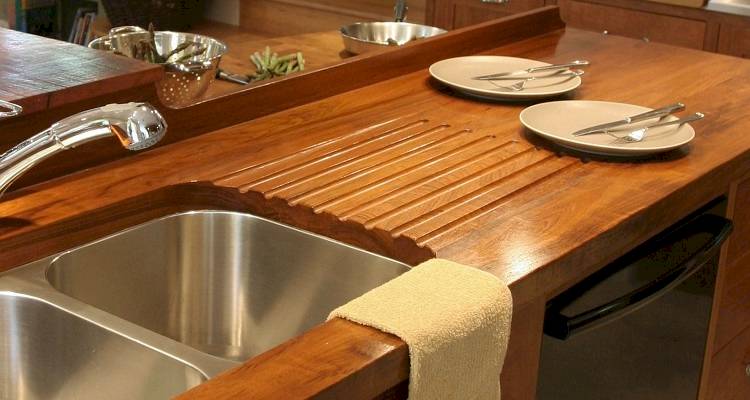
PROS ✔
Because of the way these sinks fall in the countertop, these sinks allow cleaning to be simpler as you can sweep any waste into the sink without having to go over or around a sink rim. These sinks blend more seamlessly into the kitchen and often a higher quality sink.
CONS ✖
Because of the way the sink and the counter meet, it is difficult to clean as gunk can build under the countertop. Another con is that these sinks are generally more expensive to purchase and install.
Farmhouse
This is also known as an apron sink. The sink itself is rustic in appearance, and it's commonly found in farmhouse kitchens which is where it gets its name from. This type of sink is usually placed in the middle of a countertop and cutting is required.
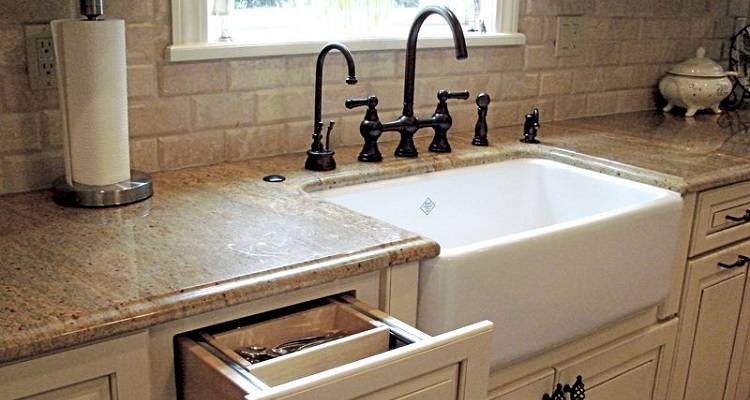
PROS ✔
The size of these sinks is large in size, which is perfect for washing larger utensils. The overall look of this sink is rustic and aesthetically pleasing, making it a popular sink for the home.
CONS ✖
These can be expensive due to their style and installation. It is also important to bear in mind that these sinks can be prone to dipping.
Sink Repair
Sinks are an essential part of any household, so it is crucial to know how to maintain them and know what to do in the face of any repairs that need tackling.
Drainage is usually one of the most common problems you will face in regard to your sink. Drains and pipes can often get clogged with debris such as hair, food, and dirt, so it is important that regular cleaning is maintained in order to prevent any clogging and build up.
Easy ways to keep on top of this to use a mixture of white vinegar and a small amount of baking soda and run the hot tap to wash this mixture down the sink. Avoid chemical cleaners where you can as the fumes can be powerful and harmful to breathe in.
As well as regular drain cleaning, you will also need to ensure you clean the drain trap. You want to have a regular flow of water with no debris blocking the flow.
If unfortunately, you find a leakage or clog, then you should really call a professional plumber to fix the problem area. Plumbers can be expensive, but when it comes to leaking water, you don't want to mess around.
How to Remove Sink
When it comes to renovating your home or just chasing to redecorate a room, it's out with the old and in with the new. You might be considering upgrading your sink, and before you can replace the old with a newer model, you will need to know how to remove a sink. It might seem like a complicated task but removing a sink can be done by even the most inexperienced DIY goer.
Before you begin to remove the current sink, you will need to turn the water supply off. To do this, locate the valves behind the sink. If you don't have shut-off valves, then you will need to shut off the water supply at the main stopcock.
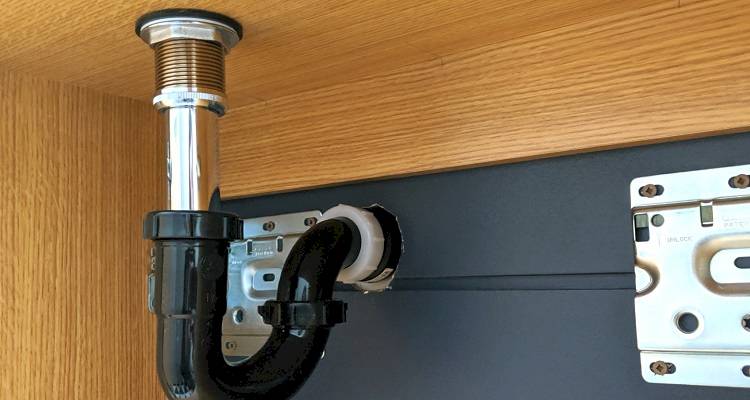
Next, you will need to remove the P-Trap, which is the U shaped section of the drainpipe. Using pliers, you need to loosen the nuts which hold the P-Trap in place. Before doing this, you will need to place a bucket beneath the area to catch any water drops.
Now, you will need to remove the clips which fasten the sink directly to the countertop. Use a screwdriver to loosen and remove the clips.
Once the clips are removed, you will need to remove the sealant. You can do this using a utility knife which can be used to loosen the sealant.
Finally, you cannot remove the sink by lifting it straight from the countertop. If the sink is stuck, check all the slant has been removed, and any clips or blots are off.

